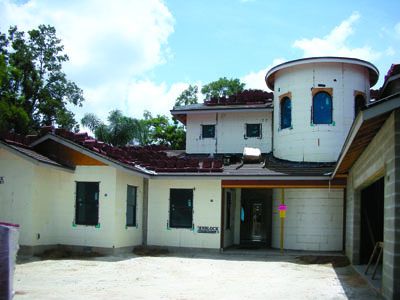
This home is 50 percent more energy efficient than a typical home thanks to recylced and non-toxic materials.
Green Florida
Can a luxurious home be a green home? Absolutely. These days, green construction doesn’t mean sod roofs and windmills. Thanks to modern building materials and technologies, the most eco-friendly homes don’t necessarily look any different from surrounding homes. They do act differently, however.
Take, for example, this home, which was built on a Central Florida infill lot. It’s now complete, but these under-construction photos allow us to point out some of the green features no one will ever see.
Thanks to those features, the home meets standards set by the Florida Green Building Coalition, Florida Water Star and Energy Star. It will also be entered in the Department of Energy’s upcoming Builders Challenge.
The home is 50 percent more energy efficient than a typical home and was built using, as much as possible, recycled and nontoxic materials. The Florida-friendly landscape promotes water-conservation.
1. Recycling construction waste. Glass, cardboard, wood, metal, concrete and other construction waste is sent to a recycling center instead of the landfill.
2. Erosion control. Barriers were built around the site and hay bales placed at access points to prevent erosion and storm water runoff and to keep from contaminating surrounding properties.
3. Saving the trees. Fences were placed around existing trees and on neighboring properties to protect the trees and their root systems.
4. Roof protection. The ZIP Wall system is a durable, moisture-resistant barrier system that also promotes energy efficiency by helping to maintain the R-value of the home’s insulation. It also contains no urea formaldehyde, which helps promote indoor air quality and meet the requirements of the Sustainable Forest Initiative Program.
On the roof. Concrete roof tiles are Energy Star-certified and sourced from a local company, which means less energy was used to transport the product.
Overhangs. Two-foot-deep overhangs divert rain away from the home and prevent solar heat gain, which means air conditioning systems won’t have to work as hard.
Insulated Concrete Forms. Green- block Insulated Concrete Forms create steel-reinforced concrete wall systems that are storm-resistant and energy-efficient. ICFs, which also help to block outside noise, are made from a nontoxic expandable polystyrene that can be recycled.
5. Reuse. Reusing plywood from another jobsite saved the crew from using about 35 new sheets on the home’s steps and dome.
6. Windows and doors. Using win-dows and doors that exceed Energy Star ratings will lower energy bills. Windows are sealed and taped for even more efficiency.
7. Framing the house. Engineered wood products and materials such as finger-jointed studs are more dimensionally stable than solid-sawn studs, and they preserve resources because they’re made of wood remnants.
Treated wood. Borate pressure-treated lumber is non-toxic and protects against termites, insects and fungal decay including dry rot.
8. Ducts. Duct joints are sealed with mastic inside and out to prevent air leaks; a “smoke” test reveals any leakage problems.
Indoor air quality. Energy Star-certified bathroom exhaust fans will remove humidity and pollutants from the home and prevent mold and mildew. A central vacuum system will remove allergy-causing dust.
9. Nontoxic sealants. To help maintain indoor air quality, low-VOC (volatile organic compound) sealants are
used on any cuts made in the slab for plumbing and electrical work and on PVC pipes.
5 ENERGY-SAVING TIPS
> Set your air conditioning thermostat at 78 degrees in the summer and 68 degrees in the winter. Air conditioning and heating account for more than 50 percent of a typical electric bill.
> Install ceiling fans throughout your home. By doing so, you could raise your thermostat several degrees and not feel the difference. Turn fans off in unoccupied areas.
> Close those curtains. Or mini-blinds, or shutters and you’ll keep the summer’s heat out. During the winter, open your shades again and let the sun shine in.
> Close the refrigerator door. Try to decide what you want before you open it in the first place. Frequently opening and closing the refrigerator door increases your electric bill.
> Change or clean heating and air-conditioning filters monthly. Dirty filters put an unnecessary strain on the unit and can increase operating costs.
